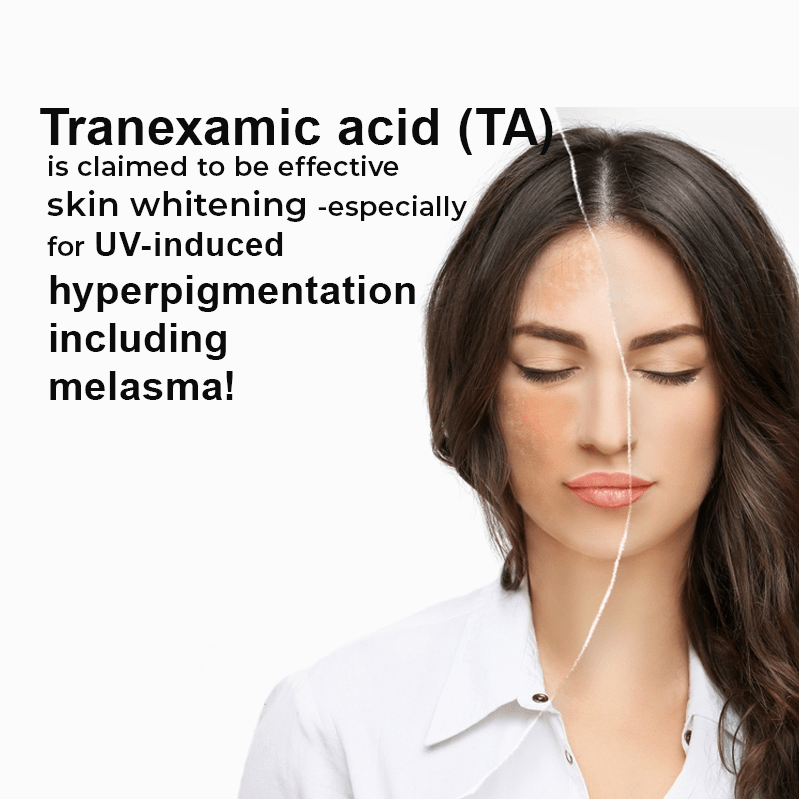
Blog
Tranexamic acid (TA) is claimed to be effective skin whitening – especially for UV-induced hyperpigmentation including melasma!
- By admin on
- March 12, 2024
Melasma, a disorder of hyperpigmentation and vascularization, causes vascular abnormalities. It seems like light-to-dark brown spots. It has a profound impact on individuals, especially women between the ages of 20 and 40. It can lead to reduced social interaction, decreased social performance at work or school, and a decline in confidence and self-esteem.
The onset is unknown, but melasma often appears in excessive sun exposure, hormonal imbalances, family history, some medications or once etiopathogenesis (chronic inflammation and acute thrombosis) remains unclear. Our face, forearms, and back skin are most vulnerable to melasma severity.
But there is hope, as melasma can be managed and treated.
Factors that induce melasma include;
- Melasma is often treated with topical hydroquinone (HQ), but this treatment may not always yield satisfactory results.
- Tranexamic acid (TXA) is an α2-antiplasmin (plasmin inhibitor) used off-label in treating melasma.
- TXA can be administered topically in cosmeceutical forms, orally in medicine forms, or intralesionally, depending on the individual’s condition and the recommendation of a healthcare professional.
Tranexamic acid (TXA) has emerged as an effective antifibrinolytic agent in reducing the fatality effects of melasma. By blocking the melanogenesis process, TXA can help lighten and reduce hyperpigmentation. The exact mechanism behind the whitening effect of Tranexamic acid is still not fully understood, but it is believed to inhibit the production of melanin and suppress the transfer of pigment to the skin cells.
Melasma can be classified into epidermal, dermal, or mixed types based on the depth of melanogenesis. The Melasma Area and Severity Index (MASI) and modified Melasma Area and Severity Index (mMASI) are used for assessment.
Exploring Different Treatment Modalities for Melasma By Using Tranexamic Acid!
Melasma, a hyperpigmentation disorder, can have a significant impact on individuals’ quality of life. Various treatment approaches have been employed to manage melasma, reduce pigmentation and improve skin appearance.
Recently, researchers have turned their attention to the potential benefits of Tranexamic acid (TXA), traditionally used as a Hemostatics drug, in treating melasma.
Let’s explore the use of different treatment modalities for melasma, focusing particularly on the promising effects of Tranexamic acid.
.
Elimination of Possible Causative Factors:
Treating melasma often involves the identification and elimination of any possible causative factors. It is important to address underlying hormonal imbalances, discontinue medications that may exacerbate melasma, and limit exposure to UV radiation. By reducing or eliminating these triggers, the severity and progression of melasma can potentially be controlled.
Use of Sunscreen and Hypopigmenting Agents:
Sun protection plays a crucial role in melasma management. The consistent use of broad-spectrum sunscreen with a high sun protection factor (SPF) helps to shield the skin from harmful UV rays.
Additionally, a range of hypopigmenting agents, such as topical hydroquinone and kojic acid, may be prescribed to reduce melanin production and fade pigmentation
Laser Therapy:
Laser therapy has emerged as a popular treatment option for melasma. Laser devices, including Q-switched lasers (used for removing acne scars, age-related wrinkles, and onychomycosis) and fractional lasers, can help target and break down the excess melanin deposits responsible for pigmentation. But that triggers costly procedures.
Careful Choice of Cosmetics: Use skincare and hair products should be oil-free and labelled noncomedogenic to avoid clogging pores. However, some people may still experience acne breakouts from these products.
The Potential of Tranexamic Acid:
Recent studies have shed light on the potential benefits of tranexamic acid in treating melasma. Researchers have found that TXA not only exhibits hypopigmented effects on melasma lesions but also has a preventive role against UV-induced pigmentation. The anti-plasmin activity of tranexamic acid is believed to be the main mechanism behind its hypopigmented effect.
Promising Clinical Trials:
Clinical trials exploring localized microinjection of tranexamic acid have shown promising results. Participants experienced a significant decrease in the Melasma Area and Severity Index (MASI) score after 8 weeks of use, with no significant side effects reported. These findings signify the potential efficacy and safety of tranexamic acid (TXA) as a treatment modality for melasma.
Moreover, tranexamic acid has shown promising results in hypopigmentation and prevention of melasma. With further research and clinical trials, tranexamic acid may offer a new dimension in the treatment of this challenging condition. As always, it is essential to consult with a dermatologist or healthcare professional for an accurate diagnosis and personalized treatment plan.
Comparing the Safety and Efficacy of Tranexamic Acid and Hydroquinone for Melasma Treatment!
In another study (Kondou et al), researchers compared the safety and efficacy of topical solutions containing tranexamic acid (TA) with those containing hydroquinone (HQ) and dexamethasone in treating melasma.
Let’s highlight the findings and implications of these studies.
The use of a TA emulsion showed promising results in improving pigmentation in subjects with melasma and freckles. The study reported an 80% improvement in pigmentation among subjects with melasma and a 75% improvement among subjects with freckles. This suggests the potential efficacy of TA in managing not only melasma but also other pigmentation-related conditions.
Found Significant Decrease in Epidermal Pigmentation:
Another recent study investigated the effects of both oral and topical TA over 8 weeks. The results indicated a significant decrease in epidermal pigmentation and a reversion of dermal changes associated with melasma.
This suggests that TA, whether administered orally or topically, may offer substantial benefits in reducing melasma-related pigmentation and improving overall skin appearance.
In another clinical trial, 74 participants were given 250 mg of TXA twice a day for six months. Within the first one to two months of treatment, 94.6% of participants reported significant improvement in their melasma condition.
By the end of the six months, 95.9% of patients observed fair to excellent improvement in their melasma.
For people unable to handle oral TXA or prefer not to take medication orally for melasma, topical TXA offers a viable option to directly treat the skin. The majority of dermatologists recommended TXA 5% and 2%.
Comparing TA with HQ and Dexamethasone:
A separate study aimed to compare the safety and efficacy of a topical solution containing 3% TA with a topical solution containing 3% hydroquinone and 0.01% dexamethasone with the treatment of melasma.
The study aimed to evaluate improvements in hyperpigmentation, skin texture, and overall satisfaction with treatment. The findings of this study will help guide global dermatologists in determining the most suitable treatment option for their melasma patients.
In a study, 60 women were compared over 12 weeks, with topical TXA 5% and HQ (Hydroquinone) 2% being randomized and double-blinded. In addition to daily SPF 30, both groups were instructed to use the topical solution twice daily on the affected areas. Despite a significant decrease in MASI scores for both groups, there was no notable difference between them. Despite that, the TXA group had higher patient satisfaction and fewer side effects than the HQ group.
Furthermore, the significant decrease in epidermal pigmentation and reversal of melasma-related dermal changes observed after using oral and topical TA for 8 weeks is encouraging.
Further research and larger-scale clinical trials are necessary to establish the long-term safety, efficacy, and recommended protocols for using tranexamic acid in treating melasma.
Discover Radiant Skin with DERMISQUE 3X Skin Brightening Serum:
Do you know excess sebum can lead to oily skin, clogged pores, and acne breakouts? This natural skin-lightening serum helps to maintain sebum levels, allowing your skin to remain hydrated without feeling greasy. By restoring the skin’s natural balance, your complexion will become smoother, more supple, and less prone to imperfections.
DERMISQUE 3X Skin Brightening Serum offers an impressive range of benefits for those seeking a more radiant and even skin tone. With the power of tranexamic acid, this serum works to fade acne scars, melasma-related marks, and hyperpigmentation.
DERMISQUE 3X Skin Brightening Serum contains antioxidants that work to reduce oxidative stress and protect your skin from external aggressors. By incorporating this natural skin whitening serum into your skincare routine, you can help shield your skin against damage, resulting in a youthful and vibrant appearance.
This best natural skin brightening serum also assists in preventing acne, regulating sebum, and minimizing oxidative stress. By incorporating this natural skin brightening serum into your daily routine, you can unlock the secret to achieving a luminous complexion that exudes confidence and beauty. Get glowing skin gems with DERMISQUE 3X Skin Brightening Serum and greet your queen-like radiance today.
Glow brighter, order your natural skin brightening serum today!





